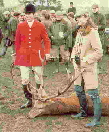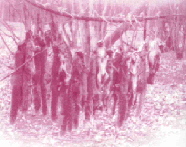The information concerning hunting is not historical yet. Foxhunting, mink and hare hunting continue, despite the ban.
(Albeit with the token addition of a bird of prey
when they are being observed.) As far as the law is concerned, hare coursing is illegal.
Shooting is unfortunately still legal.
Cub-hunting begins anytime from around
mid-August onwards. The actual start depends on when the harvest is finished,
and weather conditions. The hunt followers on horseback will surround a
wood, and dogs are sent in to kill any cubs above ground. The night before
terrier-men , working for the hunt will have blocked the entrances to any
fox earths in the wood. The fox-cubs have no escape. If they try to flee
the wood, they are frightened back in by the mounted hunt.
The foxhunting season begins in November,
when the hunt no longer surround woods, but chase the fox from piece of
cover to piece of cover across open ground.
The fox-cubs that survived have learned to run from the hounds, and
in this way the hunt get what they want, a long chase. Only the healthiest
fox will be able to sustain such a chase.
The dogs are bred for stamina, and a quick kill is not what the hunt
wants.If a fox goes below ground he may be dug out by terrier-men. Both
the fox and terrier can sustain terrible injuries, in the ensuing battle.
According to Master of Foxhounds rules, having been dug-out, the fox is
supposed to be shot. However, the fox often ends up thrown to the hounds,
or "bagged". A "bagged" fox can provide an easy kill, if the hunt fail
to find and kill another fox, above ground.
The first dog to reach the fox will bite at any part. The fox is most
often killed when caught, by bites to the stomach. He is literally disembowelled
alive. Autopsies of dead foxes have shown no evidence for the quick bite
to the back of the neck, which the hunt supporters often speak of.


Mink hunts operate from Spring to Autumn, in-between fox hunting
seasons. A mink hunt involves half the number of dogs, and a far greater
number of hunt supporters, on foot.
Mink were released into the british countryside by fur farmers, when
the price of fur collapsed. When the otter became a protected species,
the mink was used by hunters as a convenient replacement.
The dogs search the banks of a river to find the scent of a mink. When
they find it, they will start to cry out.
The mink will use it's speed and agility to evade the hounds but, as
in fox hunting, the hounds have more stamina, and the mink will often take
refuge in a hole in the bank, or a tree to escape.
If a mink goes to ground, the hunt try to flush them out by digging,
or sending in terriers, or using sticks. If a mink takes refuge in a tree,
the hunt will try to dislodge it with stones, or sticks. They have even
been known to cut down trees in their desparation to kill an animal. If
caught, a mink may be drowned, thrown to the hounds alive, or be released
to chase again.

 The brown hare is one of Britains
rarest mammals.
The brown hare is one of Britains
rarest mammals.
There are 150 hunts which, during the hunting season can kill 2 to 3 hares, even on a poor
hunting day. The hunting season lasts from September to April, and each hunt will go out at least once a week.
Because hares do not have burrows, and live above ground, they are particularly vulnerable.
Hare are reluctant to move, and often do not run until the hounds are almost on them. As in all forms of hunting
with "hounds", the animal is worn down by the greater stamina of the dogs.
As the hare tires it runs in smaller
and smaller circles, being unwilling to leave its territory.
Eventually, it is caught, and ripped apart by the
pack.

 Deer-hunting involves separate phases.
Over the course of a hunting season, the three packs which hunt Red Deer will hunt mature males from
August to October, females (called hinds), from November to February, and young males from March to April.
Deer-hunting involves separate phases.
Over the course of a hunting season, the three packs which hunt Red Deer will hunt mature males from
August to October, females (called hinds), from November to February, and young males from March to April.
In
the new forest, male Fallow Deer are hunted in September, and from November to April. Other packs
hunt Roe Bucks
As with other hunts, the stamina of the hounds wears down the selected deer,
and when the hounds catch up with the exhausted animal, they will savage it, unless hunt supporters are on hand.
The Hunts say each deer is killed with a single shot. To achieve this the sawn-off shotguns which they use have to
be fired at point-blank range. However, one incident caught on film clearly shows a deer being shot four times,
before being forced underwater.
When female deer are hunted, they are often pregnant or have a calf. It is at this time of year when fat reserves
need to be maintained in order to survive the winter.
When hunted, it is common for a hind to become
separated from her calf, which will then be killed by the hounds or die of hypothermia or starvation.

 Hare coursing takes place
from September to March, and involves the chasing and killing of live hares, with 2 dogs, usually greyhounds.
Hare coursing takes place
from September to March, and involves the chasing and killing of live hares, with 2 dogs, usually greyhounds.
Hares can be driven onto a field to be "coursed" there. They can also be flushed out by a line of beaters who walk
across country. Lastly they might be released onto a field from cages, having been caught previously.
In whichever case, the hare is chased by the (faster) dog, and forced to turn, and double back, to avoid being
caught. The dogs are awarded points by a judge, according to how they cope with these turns.
The hare is often caught between 2 dogs, in a tug of war, which can last minutes. There is not always a "picker-up"
on hand who knows how to kill the hare quickly, and if one dog runs off with the hare, then catching the dog, and
killing the hare can take minutes more. In the process of being savaged, the hare is likely to suffer internal
injuries, and cry out in pain.
Brown hare numbers have seriously declined in Britain. As the hare lives above ground, farm machinery, and
chemicals cause the hare severe problems. Despite this, The European Commission denied the hare protected species
status, after The European Federation of Hunters argued against this measure.

 In
game-shooting, grouse, pheasant and wildfowl are shot and killed for sport. (The term also applies to the
shooting of mammals.)
In
game-shooting, grouse, pheasant and wildfowl are shot and killed for sport. (The term also applies to the
shooting of mammals.)
Grouse shooting begins on the 12th of August and ends in December. The birds are not hand reared, but
game-keepers kill their natural predators, and ensure an all round food supply, by sequentially burning the heather
on which they feed. Grouse fly very fast, and hitting them accurately is difficult. Many birds are simply winged,
not killed outright.
Gamekeepers are legally allowed to kill foxes stoats squirrels, and other British mammals, in order to protect the
birds. Protected animals such as badgers, often become caught in snares. Although the self-locking snare is now
illegal, the free running snare is no less cruel, as it will fray and lock as the animal struggles. Snares are
often not checked within twenty four hours, as required by law. If an animal such as a badger or deer is caught it
is likely to be released, simply to die from the infected wound.
Further to this, it is common for protected birds of prey to be killed by game-keepers. Birds, nests and chicks of
hen-harriers are destroyed. And filmed evidence of such activities has been gathered.
From October to February pheasant-shooting takes place, 12 million purpose-bred birds are shot. As
with grouse, many are wounded rather than killed outright. These birds suffer lingering deaths in the wild, if they
manage to escape capture.
As many as 1 million Wildfowl are shot annually. In addition, popular wildfowling areas are
contaminated by lead shot. When birds ingest this shot, a slow death from poisoning follows.





 The brown hare is one of Britains
rarest mammals.
The brown hare is one of Britains
rarest mammals.
 Deer-hunting involves separate phases.
Over the course of a hunting season, the three packs which hunt Red Deer will hunt mature males from
August to October, females (called hinds), from November to February, and young males from March to April.
Deer-hunting involves separate phases.
Over the course of a hunting season, the three packs which hunt Red Deer will hunt mature males from
August to October, females (called hinds), from November to February, and young males from March to April.
 Hare coursing takes place
from September to March, and involves the chasing and killing of live hares, with 2 dogs, usually greyhounds.
Hare coursing takes place
from September to March, and involves the chasing and killing of live hares, with 2 dogs, usually greyhounds.

 In
game-shooting, grouse, pheasant and wildfowl are shot and killed for sport. (The term also applies to the
shooting of mammals.)
In
game-shooting, grouse, pheasant and wildfowl are shot and killed for sport. (The term also applies to the
shooting of mammals.)